Abstract
Previously, we developed a rat model of persistent mitochondrial dysfunction based upon the chronic partial inhibition of the mitochondrial enzyme cytochrome oxidase (EC 1.9.3.1). Continuous systemic infusion of sodium azide at approximately 1 mg/kg per hr inhibited cytochrome oxidase activity and produced a spatial learning deficit. In other laboratories, glucocorticoids have been reported to exacerbate neuronal damage from various acute metabolic insults. Therefore, we tested the hypothesis that corticosterone, the primary glucocorticoid in the rat, would potentiate the sodium azide-induced learning deficit. To this end, we first identified nonimpairing doses of sodium azide (approximately 0.75 mg/kg per hr) and corticosterone (100-mg pellet, 3-week sustained-release). We now report that chronic co-administration of these individually nonimpairing treatments produced a severe learning deficit. Moreover, the low dose of corticosterone, which did not elevate serum corticosterone, acted synergistically with sodium azide to inhibit cytochrome oxidase activity. The latter result represents a previously unidentified effect of glucocorticoids that provides a candidate mechanism for glucocorticoid potentiation of neurotoxicity induced by metabolic insult. These results may have the clinical implication of expanding the definition of hypercortisolism in patient populations with compromised oxidative metabolism. Furthermore, they suggest that glucocorticoid treatment may contribute to pathology in disease or trauma conditions that involve metabolic insult.
Full text
PDF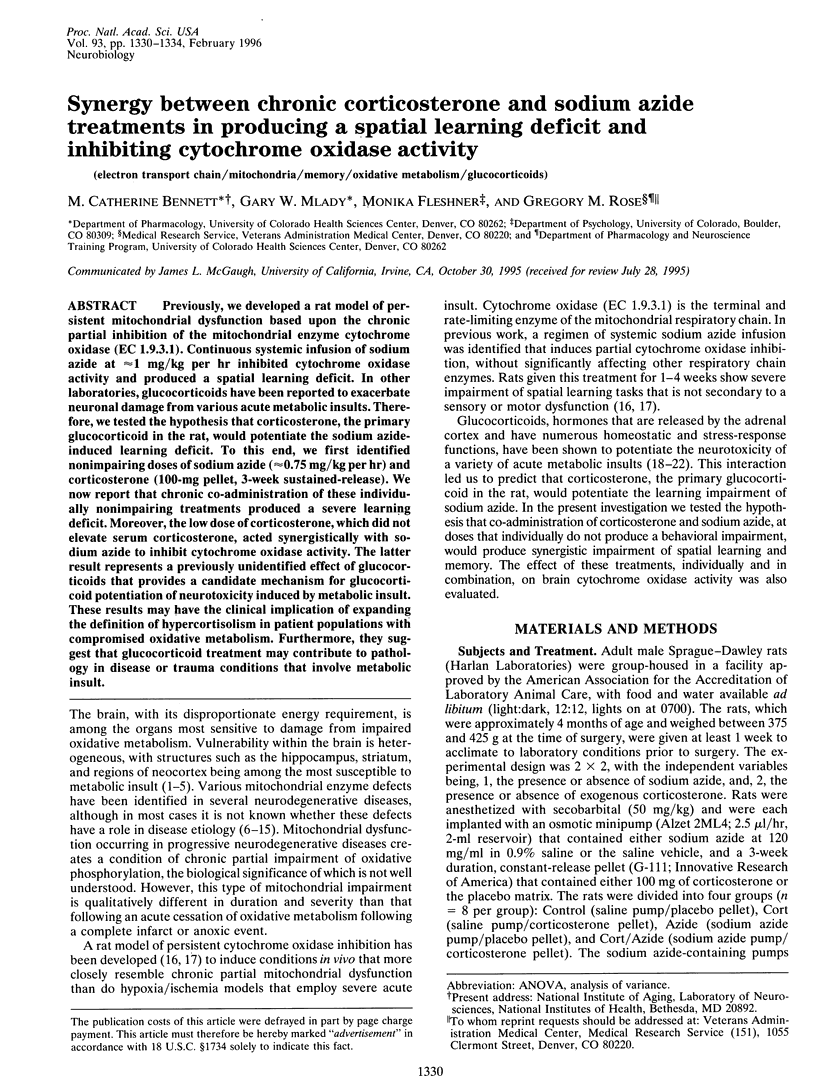
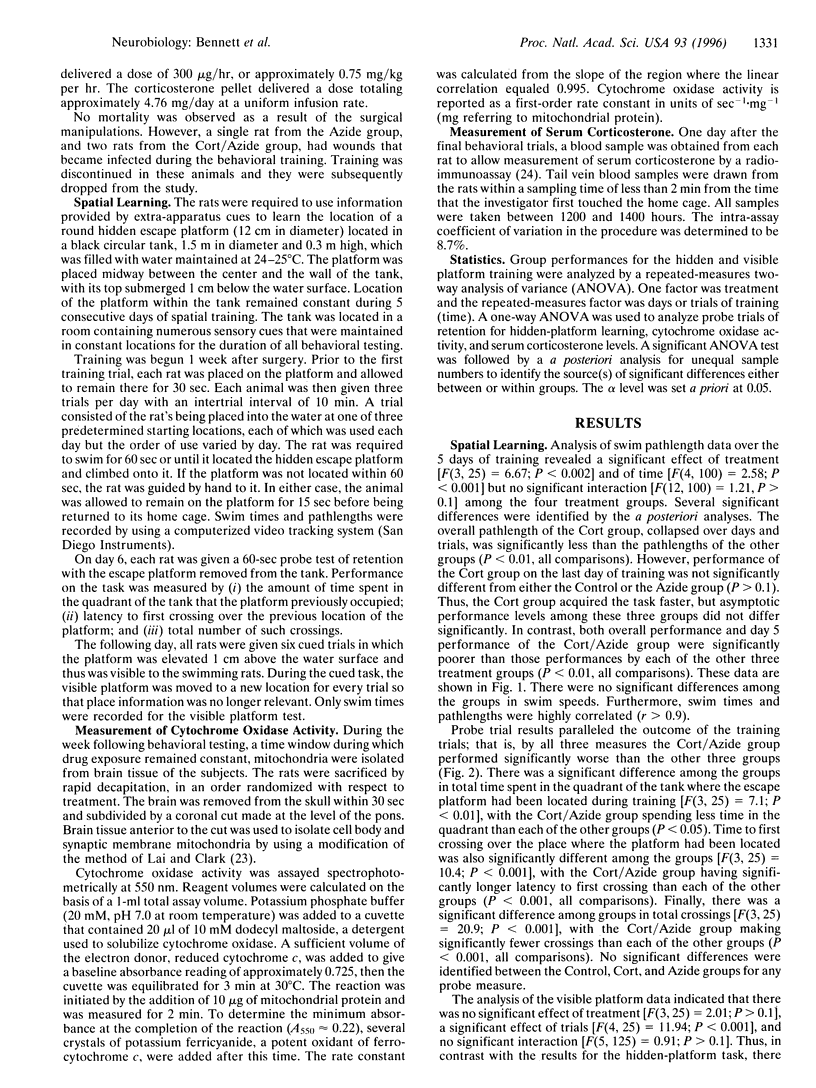
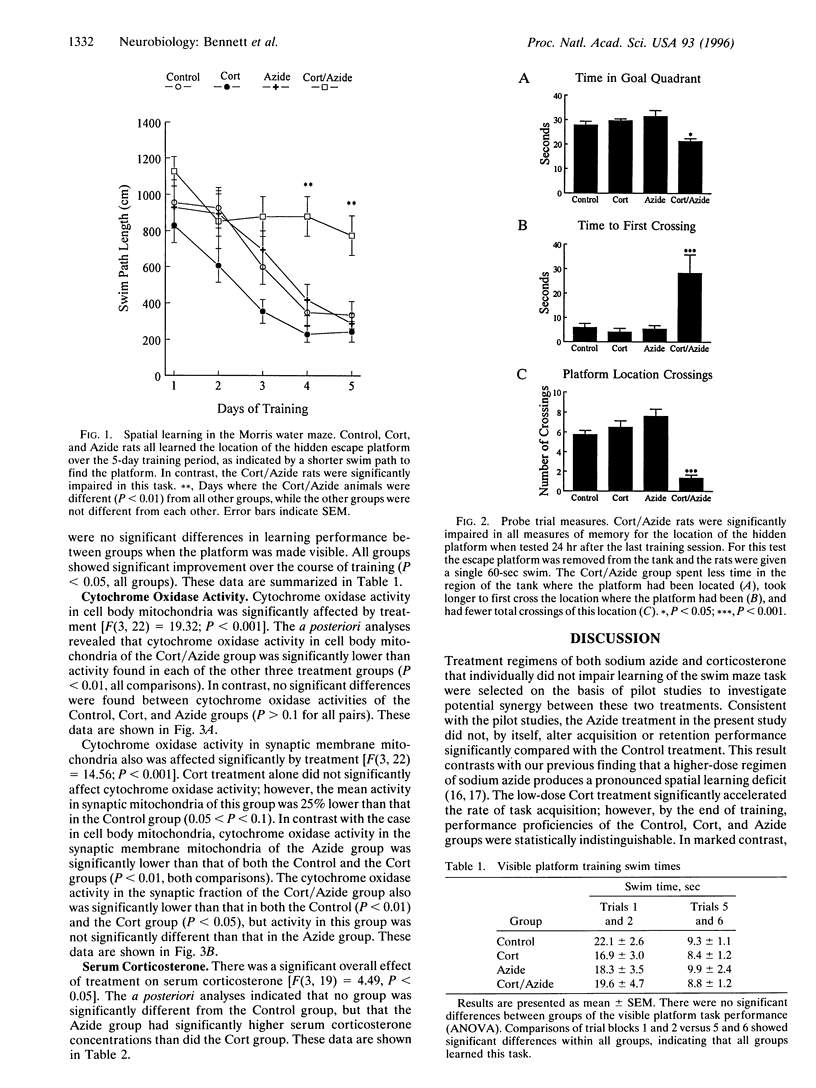
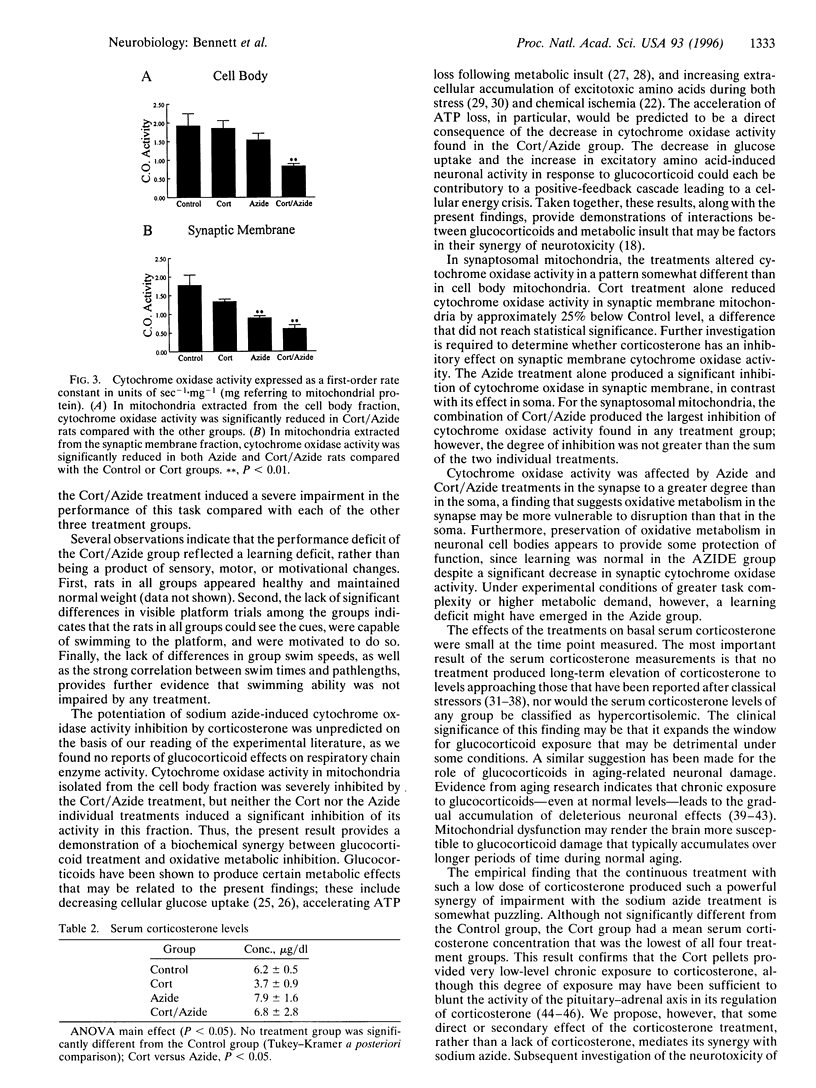
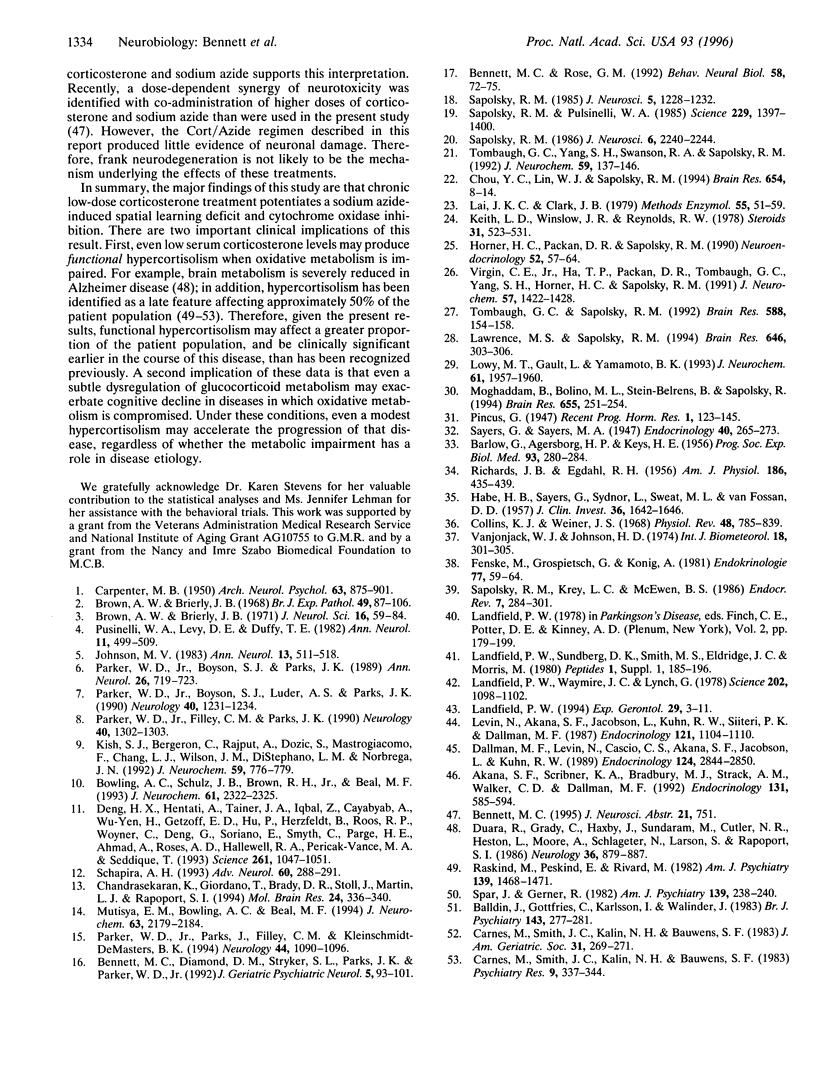
Selected References
These references are in PubMed. This may not be the complete list of references from this article.
- AGERSBORG H. P., Jr, BARLOW G., KEYS H. E. Blood levels of 17-hydroxycorticosteroids in hyperthermic dogs. Proc Soc Exp Biol Med. 1956 Nov;93(2):280–284. doi: 10.3181/00379727-93-22732. [DOI] [PubMed] [Google Scholar]
- Akana S. F., Scribner K. A., Bradbury M. J., Strack A. M., Walker C. D., Dallman M. F. Feedback sensitivity of the rat hypothalamo-pituitary-adrenal axis and its capacity to adjust to exogenous corticosterone. Endocrinology. 1992 Aug;131(2):585–594. doi: 10.1210/endo.131.2.1322275. [DOI] [PubMed] [Google Scholar]
- Balldin J., Gottfries C. G., Karlsson I., Lindstedt G., Långström G., Wålinder J. Dexamethasone suppression test and serum prolactin in dementia disorders. Br J Psychiatry. 1983 Sep;143:277–281. doi: 10.1192/bjp.143.3.277. [DOI] [PubMed] [Google Scholar]
- Bennett M. C., Diamond D. M., Stryker S. L., Parks J. K., Parker W. D., Jr Cytochrome oxidase inhibition: a novel animal model of Alzheimer's disease. J Geriatr Psychiatry Neurol. 1992 Apr-Jun;5(2):93–101. doi: 10.1177/002383099200500206. [DOI] [PubMed] [Google Scholar]
- Bennett M. C., Rose G. M. Chronic sodium azide treatment impairs learning of the Morris water maze task. Behav Neural Biol. 1992 Jul;58(1):72–75. doi: 10.1016/0163-1047(92)90967-9. [DOI] [PubMed] [Google Scholar]
- Bowling A. C., Schulz J. B., Brown R. H., Jr, Beal M. F. Superoxide dismutase activity, oxidative damage, and mitochondrial energy metabolism in familial and sporadic amyotrophic lateral sclerosis. J Neurochem. 1993 Dec;61(6):2322–2325. doi: 10.1111/j.1471-4159.1993.tb07478.x. [DOI] [PubMed] [Google Scholar]
- Brown A. W., Brierley J. B. Anoxic-ischaemic cell change in rat brain light microscopic and fine-structural observations. J Neurol Sci. 1972 May;16(1):59–84. doi: 10.1016/0022-510x(72)90102-5. [DOI] [PubMed] [Google Scholar]
- Brown A. W., Brierley J. B. The nature, distribution and earliest stages of anoxic-ischaemic nerve cell damage in the rat brain as defined by the optical microscope. Br J Exp Pathol. 1968 Apr;49(2):87–106. [PMC free article] [PubMed] [Google Scholar]
- CARPENTER M. B. Athetosis and the basal ganglia; review of the literature and study of 42 cases. Arch Neurol Psychiatry. 1950 Jun;63(6):875–901. doi: 10.1001/archneurpsyc.1950.02310240034002. [DOI] [PubMed] [Google Scholar]
- Carnes M., Smith J. C., Kalin N. H., Bauwens S. F. Effects of chronic medical illness and dementia on the dexamethasone suppression test. J Am Geriatr Soc. 1983 May;31(5):269–271. doi: 10.1111/j.1532-5415.1983.tb04869.x. [DOI] [PubMed] [Google Scholar]
- Carnes M., Smith J. C., Kalin N. H., Bauwens S. F. The dexamethasone suppression test in demented outpatients with and without depression. Psychiatry Res. 1983 Aug;9(4):337–344. doi: 10.1016/0165-1781(83)90007-0. [DOI] [PubMed] [Google Scholar]
- Chandrasekaran K., Giordano T., Brady D. R., Stoll J., Martin L. J., Rapoport S. I. Impairment in mitochondrial cytochrome oxidase gene expression in Alzheimer disease. Brain Res Mol Brain Res. 1994 Jul;24(1-4):336–340. doi: 10.1016/0169-328x(94)90147-3. [DOI] [PubMed] [Google Scholar]
- Chou Y. C., Lin W. J., Sapolsky R. M. Glucocorticoids increase extracellular [3H]D-aspartate overflow in hippocampal cultures during cyanide-induced ischemia. Brain Res. 1994 Aug 15;654(1):8–14. doi: 10.1016/0006-8993(94)91565-2. [DOI] [PubMed] [Google Scholar]
- Collins K. J., Weiner J. S. Endocrinological aspects of exposure to high environmental temperatures. Physiol Rev. 1968 Oct;48(4):785–839. doi: 10.1152/physrev.1968.48.4.785. [DOI] [PubMed] [Google Scholar]
- Dallman M. F., Levin N., Cascio C. S., Akana S. F., Jacobson L., Kuhn R. W. Pharmacological evidence that the inhibition of diurnal adrenocorticotropin secretion by corticosteroids is mediated via type I corticosterone-preferring receptors. Endocrinology. 1989 Jun;124(6):2844–2850. doi: 10.1210/endo-124-6-2844. [DOI] [PubMed] [Google Scholar]
- Deng H. X., Hentati A., Tainer J. A., Iqbal Z., Cayabyab A., Hung W. Y., Getzoff E. D., Hu P., Herzfeldt B., Roos R. P. Amyotrophic lateral sclerosis and structural defects in Cu,Zn superoxide dismutase. Science. 1993 Aug 20;261(5124):1047–1051. doi: 10.1126/science.8351519. [DOI] [PubMed] [Google Scholar]
- Duara R., Grady C., Haxby J., Sundaram M., Cutler N. R., Heston L., Moore A., Schlageter N., Larson S., Rapoport S. I. Positron emission tomography in Alzheimer's disease. Neurology. 1986 Jul;36(7):879–887. doi: 10.1212/wnl.36.7.879. [DOI] [PubMed] [Google Scholar]
- EGDAHL R. H., RICHARDS J. B. Effect of acute hyperthermia on adrenal 17-hydroxycorticosteroid secretion in dogs. Am J Physiol. 1956 Sep;186(3):435–439. doi: 10.1152/ajplegacy.1956.186.3.435. [DOI] [PubMed] [Google Scholar]
- Fenske M., Grospietsch G., König A. Plasma glucocorticosteroid and aldosterone levels during physiological and stress conditions in rabbits. II. adult animals. Endokrinologie. 1981 Mar;77(1):59–64. [PubMed] [Google Scholar]
- HALE H. B., SAYERS G., SYDNOR K. L., SWEAT M. L., VAN FOSSAN D. D. Blood adrenocorticotrophic hormone and plasma corticosteroids in men exposed to adverse environmental conditions. J Clin Invest. 1957 Dec;36(12):1642–1646. doi: 10.1172/JCI103564. [DOI] [PMC free article] [PubMed] [Google Scholar]
- Horner H. C., Packan D. R., Sapolsky R. M. Glucocorticoids inhibit glucose transport in cultured hippocampal neurons and glia. Neuroendocrinology. 1990 Jul;52(1):57–64. doi: 10.1159/000125539. [DOI] [PubMed] [Google Scholar]
- Keith L. D., Winslow J. R., Reynolds R. W. A general procedure for estimation of corticosteroid response in individual rats. Steroids. 1978 Apr;31(4):523–531. doi: 10.1016/0039-128x(78)90034-x. [DOI] [PubMed] [Google Scholar]
- Kish S. J., Bergeron C., Rajput A., Dozic S., Mastrogiacomo F., Chang L. J., Wilson J. M., DiStefano L. M., Nobrega J. N. Brain cytochrome oxidase in Alzheimer's disease. J Neurochem. 1992 Aug;59(2):776–779. doi: 10.1111/j.1471-4159.1992.tb09439.x. [DOI] [PubMed] [Google Scholar]
- Lai J. C., Clark J. B. Preparation of synaptic and nonsynaptic mitochondria from mammalian brain. Methods Enzymol. 1979;55:51–60. doi: 10.1016/0076-6879(79)55008-3. [DOI] [PubMed] [Google Scholar]
- Landfield P. W. Nathan Shock Memorial Lecture 1990. The role of glucocorticoids in brain aging and Alzheimer's disease: an integrative physiological hypothesis. Exp Gerontol. 1994 Jan-Feb;29(1):3–11. doi: 10.1016/0531-5565(94)90058-2. [DOI] [PubMed] [Google Scholar]
- Landfield P. W., Waymire J. C., Lynch G. Hippocampal aging and adrenocorticoids: quantitative correlations. Science. 1978 Dec 8;202(4372):1098–1102. doi: 10.1126/science.715460. [DOI] [PubMed] [Google Scholar]
- Lawrence M. S., Sapolsky R. M. Glucocorticoids accelerate ATP loss following metabolic insults in cultured hippocampal neurons. Brain Res. 1994 May 23;646(2):303–306. doi: 10.1016/0006-8993(94)90094-9. [DOI] [PubMed] [Google Scholar]
- Levin N., Akana S. F., Jacobson L., Kuhn R. W., Siiteri P. K., Dallman M. F. Plasma adrenocorticotropin is more sensitive than transcortin production or thymus weight to inhibition by corticosterone in rats. Endocrinology. 1987 Sep;121(3):1104–1110. doi: 10.1210/endo-121-3-1104. [DOI] [PubMed] [Google Scholar]
- Lowy M. T., Gault L., Yamamoto B. K. Adrenalectomy attenuates stress-induced elevations in extracellular glutamate concentrations in the hippocampus. J Neurochem. 1993 Nov;61(5):1957–1960. doi: 10.1111/j.1471-4159.1993.tb09839.x. [DOI] [PubMed] [Google Scholar]
- Moghaddam B., Bolinao M. L., Stein-Behrens B., Sapolsky R. Glucocorticoids mediate the stress-induced extracellular accumulation of glutamate. Brain Res. 1994 Aug 29;655(1-2):251–254. doi: 10.1016/0006-8993(94)91622-5. [DOI] [PubMed] [Google Scholar]
- Mutisya E. M., Bowling A. C., Beal M. F. Cortical cytochrome oxidase activity is reduced in Alzheimer's disease. J Neurochem. 1994 Dec;63(6):2179–2184. doi: 10.1046/j.1471-4159.1994.63062179.x. [DOI] [PubMed] [Google Scholar]
- Parker W. D., Jr, Boyson S. J., Luder A. S., Parks J. K. Evidence for a defect in NADH: ubiquinone oxidoreductase (complex I) in Huntington's disease. Neurology. 1990 Aug;40(8):1231–1234. doi: 10.1212/wnl.40.8.1231. [DOI] [PubMed] [Google Scholar]
- Parker W. D., Jr, Boyson S. J., Parks J. K. Abnormalities of the electron transport chain in idiopathic Parkinson's disease. Ann Neurol. 1989 Dec;26(6):719–723. doi: 10.1002/ana.410260606. [DOI] [PubMed] [Google Scholar]
- Parker W. D., Jr, Filley C. M., Parks J. K. Cytochrome oxidase deficiency in Alzheimer's disease. Neurology. 1990 Aug;40(8):1302–1303. doi: 10.1212/wnl.40.8.1302. [DOI] [PubMed] [Google Scholar]
- Parker W. D., Jr, Parks J., Filley C. M., Kleinschmidt-DeMasters B. K. Electron transport chain defects in Alzheimer's disease brain. Neurology. 1994 Jun;44(6):1090–1096. doi: 10.1212/wnl.44.6.1090. [DOI] [PubMed] [Google Scholar]
- Pulsinelli W. A., Levy D. E., Duffy T. E. Regional cerebral blood flow and glucose metabolism following transient forebrain ischemia. Ann Neurol. 1982 May;11(5):499–502. doi: 10.1002/ana.410110510. [DOI] [PubMed] [Google Scholar]
- Raskind M., Peskind E., Rivard M. F., Veith R., Barnes R. Dexamethasone suppression test and cortisol circadian rhythm in primary degenerative dementia. Am J Psychiatry. 1982 Nov;139(11):1468–1471. doi: 10.1176/ajp.139.11.1468. [DOI] [PubMed] [Google Scholar]
- Sapolsky R. M. A mechanism for glucocorticoid toxicity in the hippocampus: increased neuronal vulnerability to metabolic insults. J Neurosci. 1985 May;5(5):1228–1232. doi: 10.1523/JNEUROSCI.05-05-01228.1985. [DOI] [PMC free article] [PubMed] [Google Scholar]
- Sapolsky R. M. Glucocorticoid toxicity in the hippocampus: reversal by supplementation with brain fuels. J Neurosci. 1986 Aug;6(8):2240–2244. doi: 10.1523/JNEUROSCI.06-08-02240.1986. [DOI] [PMC free article] [PubMed] [Google Scholar]
- Sapolsky R. M., Krey L. C., McEwen B. S. The neuroendocrinology of stress and aging: the glucocorticoid cascade hypothesis. Endocr Rev. 1986 Aug;7(3):284–301. doi: 10.1210/edrv-7-3-284. [DOI] [PubMed] [Google Scholar]
- Sapolsky R. M., Pulsinelli W. A. Glucocorticoids potentiate ischemic injury to neurons: therapeutic implications. Science. 1985 Sep 27;229(4720):1397–1400. doi: 10.1126/science.4035356. [DOI] [PubMed] [Google Scholar]
- Schapira A. H. Mitochondrial complex I deficiency in Parkinson's disease. Adv Neurol. 1993;60:288–291. [PubMed] [Google Scholar]
- Spar J. E., Gerner R. Does the dexamethasone suppression test distinguish dementia from depression? Am J Psychiatry. 1982 Feb;139(2):238–240. doi: 10.1176/ajp.139.2.238. [DOI] [PubMed] [Google Scholar]
- Tombaugh G. C., Sapolsky R. M. Corticosterone accelerates hypoxia- and cyanide-induced ATP loss in cultured hippocampal astrocytes. Brain Res. 1992 Aug 14;588(1):154–158. doi: 10.1016/0006-8993(92)91356-j. [DOI] [PubMed] [Google Scholar]
- Tombaugh G. C., Yang S. H., Swanson R. A., Sapolsky R. M. Glucocorticoids exacerbate hypoxic and hypoglycemic hippocampal injury in vitro: biochemical correlates and a role for astrocytes. J Neurochem. 1992 Jul;59(1):137–146. doi: 10.1111/j.1471-4159.1992.tb08884.x. [DOI] [PubMed] [Google Scholar]
- Vanjonack W. J., Johnson H. D. effectEffect of sulphur dioxide (SOz) and heat (35C) stressors on plasma glucocorticoids and thyroxine levels in mice. Int J Biometeorol. 1974 Dec;18(4):301–305. doi: 10.1007/BF01463719. [DOI] [PubMed] [Google Scholar]
- Virgin C. E., Jr, Ha T. P., Packan D. R., Tombaugh G. C., Yang S. H., Horner H. C., Sapolsky R. M. Glucocorticoids inhibit glucose transport and glutamate uptake in hippocampal astrocytes: implications for glucocorticoid neurotoxicity. J Neurochem. 1991 Oct;57(4):1422–1428. doi: 10.1111/j.1471-4159.1991.tb08309.x. [DOI] [PubMed] [Google Scholar]


